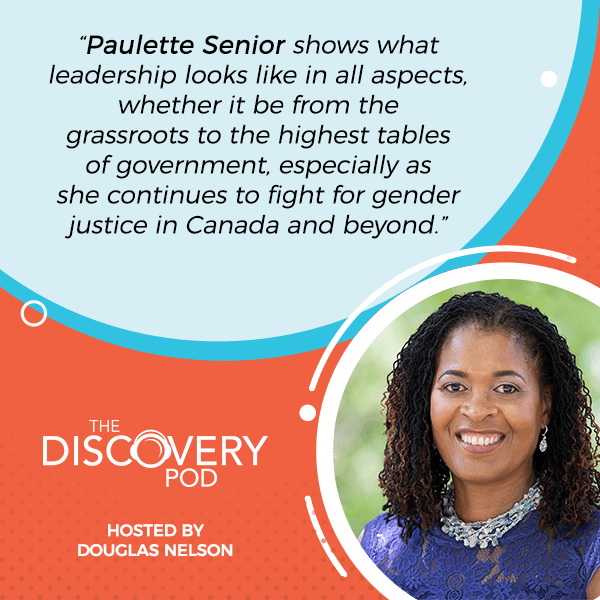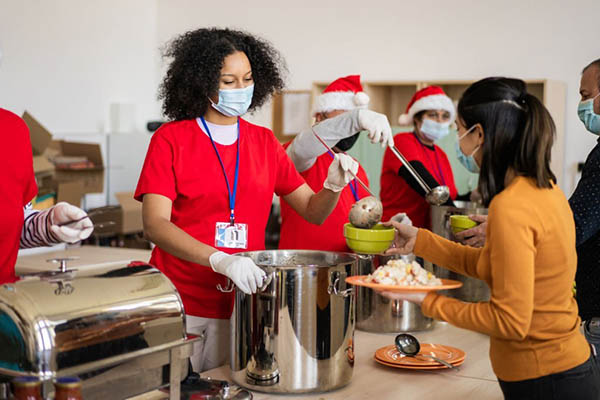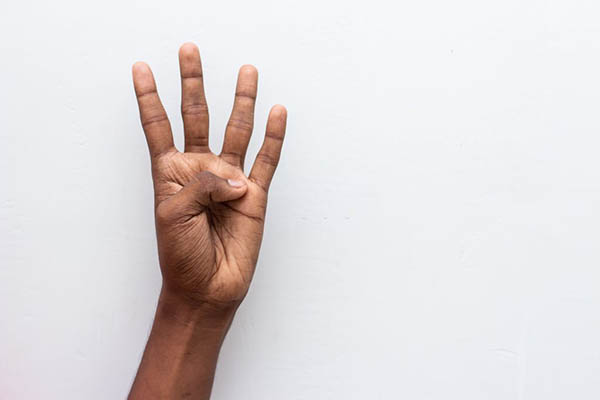
Despite today’s society being much better off than the last century, inequality remains in the area of women’s rights. In today’s episode, CEO of the Canadian Women’s Foundation Paulette Senior talks about her work in empowering women to assert their rights and advocating gender justice. Paulette shares the unique ways she and her organization have helped women from vulnerable sectors, from her work in women’s shelters to leadership roles in the Canadian government. Tune in and find out Paulette’s advocacies and how you can take part in the movement to push for better women’s rights.
—
Listen to the podcast here
Canadian Women’s Foundation With Paulette Senior
In this very special International Women’s Day edition of the show, we are pleased to have Paulette Senior. Paulette is the CEO of the Canadian Women’s Foundation, a leader in gender justice, and a champion in our social profit sector. Paulette shares her insights on what International Women’s Day means in Canada, and what we can all do to improve gender justice in our country and beyond.
As we go through our conversation, Paulette shares some important and powerful examples of what leadership looks like in our sector, what leadership looks like at the grassroots, what it looks like at the highest senior tables of government, and how you motivate and inspire a team and a movement everywhere in between. If you are leading an organization, want to lead an organization, or are curious about what great leadership looks like in our sector, you are going to want to learn more about what Paulette has to say. Happy International Women’s Day.
—
Welcome, Paulette. It’s great to have you on the show.
Thank you. It’s great to join you. Thanks for having me.
For our audience who aren’t familiar with the Canadian Women’s Foundation, can you explain what your organization does and who it serves?
I’m happy to do that. It’s always good to have a bit of commercial space. The Canadian Women’s Foundation is Canada’s national foundation for gender justice. We have been around for over 30 years. We were founded by a group of women at the time who were quite dissatisfied with the number of resources that were going towards addressing issues around gender equality generally.
They came up with establishing the Gay Women’s Foundation so that they could have funds directly going towards organizations that were addressing issues around gender equality, specifically gender-based violence, and women’s leadership. They are looking at issues around girls, building their self-esteem and potential, as well as women’s economic development, and being able to address issues around poverty. That’s what we are still doing now.
The issues have changed. Their attention has changed. You have dedicated much of your career to the social profit sector and specifically to organizations that support women. You have been in your role for over six years, and ten years as CEO of YWCA Canada before that. What drew you to this career?
I don’t know that I had much of a choice. I was looking for work that would be aligned with the issues that I was seeing around me, including issues that I was experiencing at the time. I was raised in an immigrant family that settled here in the ’60s. I had parents who were blue-collar workers. I came as an eleven-year-old kid to Canada. I was experiencing issues of exclusion and racism, and trying to find a place where I could belong like the way that I felt belonged back in Jamaica.
These issues have always been playing out in my life. They led me to make choices and decisions in my life. I saw that playing out in my friends’ lives and what they were doing. Many years later, having the opportunity to address some of these issues of exclusion and gender, helping people to find their path in life, and being able to support them in doing that, I consider that a fulfilling experience. Having done that on the front lines by directly delivering those services, but also to be leading the organizations that deliver those services is a real satisfying joy for me. That has me waking up every morning knowing I have something important and meaningful to do.
That’s an important point. The idea of not only seeing that there is a need in the community but being able to be leading organizations that are delivering on that need, or supporting people who are facing the need every day. I had a conversation with my daughter who’s thirteen and has been very enlightened for her whole life, and has a very distinct memory of her first encounter with gender inequality. She was so aghast. She had discovered it in her mind. She was the first one to figure it out and could not believe that this existed. Do you have a memory or do you have a moment where you realized that this was an issue and that sense of surprise or outrage?
I even saw it. I have a few moments, but when I look back, for example, at assumptions that were made because of the body that I live in, assumptions about my ability, presumptions in fact about what I could and couldn’t do, and that was in a number of ways academically. I had the experience of being streamed into lower-level classes because it was thought that I wasn’t smart enough or all that stuff, and I was in a state of shock.
I realized that there was something else at play here. I probably wasn’t as smart as your daughter back then, but I realized that there was something that wasn’t right. That unsettling feeling left me wandering because I wasn’t born into this society, so I didn’t understand what was at play. Quite frankly, I didn’t name it for many years. I had no idea what it was.
As I got older and went through my educational journey, it probably wasn’t until I got early post-secondary that it all came together for me in this awakening. I felt that perhaps in the previous years, I was still in the space of walking on with great uncertainty and trying to find my way over barriers. I would try my best to get over them, but not putting the picture together until I got to university.
When working with young women through your work both now and in the past, and you see them encountering some of the same barriers that you encountered, what wisdom or emotion that you share with them as you are watching what other young women go through?
It’s important to show immense empathy and understanding. I lead with that and it’s important to lead with that because I wish I had that when I was younger. I wish that was there for me in a way that made sense to me. When you think of the fact that girls and young women are still growing and still finding their footing and place in the world, having someone there to be able to say, “Yes, I get it. I have been there and I understand it,” and helping them to find who they are.
When working with young women, it’s important to lead with immense empathy and understanding. Share on XThe solutions have to come from who they are. Not because I walk a particular path and therefore that’s a path they should take. I can share my story and then help them to crystallize for themselves what their stories are, and what were their points of success, and be able to build on that in order to find their path.
I appreciate you sharing that. That’s an impactful way of approaching and looking at it. One of the things we have seen in our work with organizations across the country is we are now finished with the pandemic. I think that officially we are all done with that. Nobody wants to talk about it anymore.
There are so many organizations in the social profit sector that are on point to help address the challenges and inequities that were made greater through the pandemic. One of those was the disproportionate impact of the pandemic on the economic and health consequences for women in Canada in broader, but specifically in Canada. What lessons do you hope or do you think we need to learn over the course of the pandemic to help guide us through the next years here in Canada?
In this post-pandemic time that we are living in where it’s not over, but we want it to be over, it has been interesting standing here now looking back to 2020 when we were all in a state of this altered but living reality of trying to figure out what’s going to happen. We saw some things at the Canadian Women’s Foundation because of the communities that we support across the country.
We saw what was happening particularly around gender-based violence. We were hearing from shelters and other gender-based violence organizations that they were seeing spikes. While they were seeing spikes, they were also seeing incredible silence that they hadn’t seen before. Both these things were happening at the same time when folks that they were in touch with, they weren’t hearing from. They are also seeing that women had to be making the choice of defying the order to stay home and seek shelter.
As we heard from them, we are trying to figure out to how do we respond to this. As we are able to put together some resources and necessary emergency funds to address what shelters were telling us that they needed. In order to keep women safe in shelters, they had to go beyond shelter walls. They had to be going to hotels and finding alternate spaces. Being able to have the safety equipment and cleaning products that they needed to keep folks safe in a shelter.
We had to pivot to figure out how do we respond to that in a meaningful and emergent that would meet the needs. I’m proud to say that throughout that time, we did a couple of things. We were able to capture the feedback we were getting by writing a number of papers called Resetting Normal. The opportunity that we were seeing is that those who were already at the highest risk were the ones that were in the most devastating circumstances.

Canadian Women’s Foundation: Women who are at the highest risk of gender-based violence are those in the most devastating circumstances.
We can name them. We can talk about racialized and indigenous women. We can talk about women’s disabilities. We can talk about the folks who were doing that frontline work, but being paid the middle living wage line in order to protect themselves and their family. We saw that they were the ones that were being impacted the most, particularly here in the Greater Toronto area where I’m at. While we were seeing those that we were supporting in communities, we were also seeing the folks on the front lines who had to be responding to keep us safe. Particularly, those who were working in nursing homes and having to do 2 or 3 jobs to make up one salary were most at risk.
We had to respond in a way that would animate their voice and their concerns and bring that to the government. Bring that to the folks who have money who could make a difference through their investments. We were able to do that quite successfully, I’m happy to say. We were able to quickly turn around multimillions of dollars for emergency funding to those organizations that were responding on the ground. That’s one of the things that spurred us into action.
Looking at your organization’s response to the pandemic, one of the things that jumped out at me was impressive. I’m going to ask this as you are a leader, but I assume this is a skillset within your organization. It is that ability to see the very fine detail of what’s happening to individual women, women in the community, or different groups of women, and then pivot.
Your next Zoom call is with the Federal government about where resources need to go. Being able to look at the need on the ground for individual people, and then talk about big societal change and policy, how do you balance that tension as a leader in your day, being called from small to big on an hourly or more often basis?
We are having that conversation right now because we are in the midst of strategic planning. We name it attention, and it’s about how we live within that tension. We have to accept that it exists and that is who we are. What we say is that while it is critical to be supporting organizations and grassroots communities on the ground where they are delivering these critical services, it’s important to then be able to demonstrate to the government and other important bodies what’s happening on the ground in communities.
A lot of the time it gets hidden because we do live in a stigma-infused way. It’s important that those with power and voice utilize that to be able to bring change where it needs to be. Those who are on the margins and have been pushed to the margins because of poverty, violence, or exclusion, their voices are never going to be centered. Part of our role as a foundation is to raise money to direct those funds to where they are most needed, but also to amplify those voices. Not just the voices of those who are doing the work, which is important, but the issues that they have to contend with in communities as they are doing that.
It's important that those with power and voice utilize that to be able to bring change where it needs to be. Share on XI like how you described that as tension because it is what we see with a lot of organizations in our sector that have a service delivery or working directly with grassroots organizations. That’s where the urgency for the action comes from that you see and hear every day, and the stories are all impacted.
The turning to have a conversation with a government round table, which most government round tables I have ever been a part of don’t have quite the same urgency as the needs of a grassroots organization. Being able to move at both the pace of government policy, social change, and conversation, and then to meet the needs of the day-to-day of the organizations you support. As a leader, how do you do that? In the morning, you do urgent missions and then you do longer conversations in the afternoon. Probably not, but how do you approach that?
It’s interesting but I don’t want to make it sound like I’m a magician because we are not. When the pandemic struck, we had already built a level of knowledge and credibility as a foundation addressing issues around gender equality. We had already built a reputation for this work. It landed us in a place and space where we were known to those whom we needed to be known.
They looked to us and came to us, but we were ready to bring forward the messages that they needed to hear in order to act quickly. Because we already had systems in place and we have been doing this for a long time, we had a reputation for being able to channel funds where they needed to be. We were able to say to the government that we can do this quickly, efficiently, and cheaper. That made a difference because we didn’t have to jump through hoops. We didn’t have to put organizations of funding through those hoops. When we can lower those barriers, then the work can happen much more quickly and much more directly where it needs to happen.

Canadian Women’s Foundation: When we lower those regulatory barriers, charity work can happen much more quickly and directly where it needs to happen.
It’s all of the credibility-building and relationship-building that you have done beforehand that makes those conversations happen. It makes those conversations possible when the crisis comes. Have we learned anything from the pandemic in terms of supporting the services that your foundation supports? How can we avoid having that crisis happen again?
One of the things that we knew before the pandemic was that when crisis strikes, whether you are talking wildfires, floods, or pandemics, the folks who are most at risk are those who are most vulnerable. That was already a known fact through research. We know that not just in Canada, but globally, particularly in the global south. We know that.
We responded to the wildfires by supporting women’s organizations. When we heard some of the things that were coming from those communities that we’re already supporting, we heard that women were the most vulnerable and the most at risk. We took those lessons in terms of informing what we would then be required to do. It wasn’t a surprise to us that when the pandemic struck, those who would be even more marginalized were those who were already vulnerable. It was informative for us.
Did that make you angry? Hearing you say that it’s like you knew this is what would happen and it’s exactly what happened. We knew this would happen.
That’s exactly what happened. I asked about the lessons. Anger is a legitimate form of advocacy, but so is hope at the same time. It’s important to balance these two things while we act. The lessons we learned prior and the lessons from the pandemic cannot be forgotten in terms of what we need to set up now.
One of the things that we are taking from the lessons of the pandemic is that we are organizing. We created a set of grants that we call Shock Proofing grants. This whole idea of shockproofing communities and organizations to be able to respond no matter what the crisis is one of the lessons that we are taking. We are organizing a summit to bring some of these organizations together so we can have these collective lessons of the steps that we need to put in place to further shockproof the sector from future hits that we know will happen.
If organizations and communities are shockproof, they will be able to respond no matter what the crisis. Share on XIt happens and how we can limit that for the next time. Is that right?
That’s right.
One of the great initiatives of the Canadian Women’s Foundation that you implemented is the Signal For Help tool. Can you explain what that is and how you have measured the impact of that?
It’s one of our greatest initiatives that came out of the pandemic. We weren’t expecting it, but I would say that we were prepared for it. The Signal For Help is a hand signal that someone who is working in the context of virtual calls or any situation where they may need to find a way to safely indicate that they need help could utilize this one-handed signal. That is a way of putting up your hand, trapping your thumb, and folding it over your thumb.

Canadian Women’s Foundation: The Signal For Help is putting up your hand, trapping your thumb, and folding it over your thumb.
This came to us via a PR partner that we were working with. They came to us to say, “We have an idea. We don’t know what it’s going to look like, but we feel the need to do something.” We sat down and created this tool together after some research, but fast timing to do and we called it the Signal For Help. We didn’t want it to necessarily be attached to us as something that belonged to the Canadian Women’s Foundation. We wanted this to be something that people, no matter where they are, can use that was border-free and free to use, but easy as well.
Our minds at the time were not brought up enough to imagine the ways in which people would utilize it the different ways. We thought that it was only in the format of a virtual meeting, and it would be within a controlled setting. You could indicate as you are having a conversation that you need help, and then someone could check in with you safely to see if you need help, but then we are seeing people using it in real life. We are seeing it in the US where it was used when a girl was kidnapped. We are seeing in movements globally where it has been used as well. I’m hearing that it was even being used in the Iranian uprising. It has been limitless in its use, and the full impact of that is probably not measurable.
I don’t know whether that story makes me feel chills that it’s necessary or goosebumps for how inspiring it is that something as simple, accessible, and free has had that impact in such a short period of time. How does it make you feel to think about that?
I will share with you very quickly because sometimes you create things and put them out in the world and you don’t know what’s going to happen. This is a good example of that. A friend of mine shared a story with me that she was on a call with colleagues. In the midst of that call, one of the colleagues used the signal, and she knew what it was.
She was able to find a way to safely say, “Are you okay?” I don’t know if it was through text or what have you. The person responded to say, “Call 911.” This is here in Canada, by the way. In making that call, the response was quick and she was safe. When I heard that, you talk about goosebumps, I had tears in my eyes because even though I have been a part of this work my entire life, we always talk about the fact that what we are doing is saving lives, but we don’t always get real about what that looks like. The day she told me, I was speechless for a very long time.
Another example that you have shared in our conversation so far does connect to the urgency of the moment and the need of individuals to the need for social change in a very compelling way. We are going to release this episode on International Women’s Day, so Happy International Women’s Day. It’s a time when hopefully, society is reflecting on gender equality in the work that still needs to be done. It’s one thing to focus on some progress that has been made. Why is it so important to look at the gaps in the progress and look at the progress that hasn’t been even for everyone? How do you want Canadians to be thinking about International Women’s Day and what it means in Canada?
Being a leader of two national women’s organizations in this country has taught me a lot. Being in the body I’m in doing the leading has also taught me lessons that most folks don’t get. International Women’s Day for me is about no one being left out when we talk about justice and equality and when we talk about gender justice.
It is about all of us being able to walk and live freely in a society that values what we bring. Maybe I will wrap that up by saying what Rosemary Brown who was one of our founders said, “Until all of us have made it, none of us have made it.” This is a particular quote that for me, drives us in terms of when we talk about gender justice, that it is about intersectional gender justice. Where we need to put attention is by acknowledging and seeing that those who are most at risk are the ones that we should be focusing our attention on.
Gender justice is about all of us being able to walk and live freely in society. Share on XIn your position and experience, you probably intuitively have a picture of who that is and the many who that is. For our audience, could you say a little bit more about who you are thinking of when you identify that example?
I’m thinking of folks who are targeted because of their race, gender identity, indigeneity, sexual preferences, the place they come from, the language they speak or don’t speak, how they look, and their ability or inability. All of those folks.
You have made a career of working on very important and very challenging issues. You’ve led the two largest women’s organizations in the country. How do you motivate or keep your team around you moving in that balance between anger and hope that you talked about? I can imagine the frustration, and I can’t appreciate how sharp the anger must feel sometimes.
As I have tried to ask you about that a couple of times, you have always pivoted to, “Here’s the hope, and here’s what we do.” As a leader, how do you keep your team and the individuals that you work with focused on both that granular work that gives you the urgency, and that important policy and societal level work that your foundation does so well?
It’s mutual. We keep each other. I have a great group of people that I work with. We are all drawn to the mission and vision for gender justice. That’s the beginning of it. The frustration of it is that it can’t happen soon enough. The horrible stories that we hear, whether it’s about femicide or some attack that happens in society.
We support each other. They support the hell out of me. They feed my soul because we come to this work understanding that even though we hold out the hope of a time when we are no longer needed, we realize it’s not going to be tomorrow. It is always about that. As we were doing our strap planning and we had our board session and gathered feedback from everyone, I always talk about the need that we end gender-based violence, for example. Someone will say, “Is ending it realistic? Shouldn’t we try to reduce it?” I go, “No. If we are not striving to end it, then what are we doing?”

Canadian Women’s Foundation: We come to this work understanding that even though we hold out the hope of a time when we are no longer needed, we realize it’s not going to be tomorrow.
How much is acceptable? If we are not trying to end it, how much of it is okay with it? That’s right.
Working to end it, we will reduce it, but we must strive to end it. It’s a great question.
When you are faced with a challenge in your leadership role, who do you turn to for advice? Who do you bounce ideas off of or say, “I have this question I want to work through?”
Especially during this time that we have been shut in, it has been hard to persevere. It’s a couple of things. What keeps me going is when we see whether it’s a corporate partner, a major gift individual, or the government step up to the plate and say, “We have this and we think you are the one that we want to work with to do it.” These partnerships are so inspiring.
I look at the people around me. My family and friends nourish me. I have a son. He’s an incredible individual whom I look up to. I’m inspired by him and he’s also become a justice advocate. He’s an educational professional. He works within education. People say, “He’s following your footstep.” I go, “I don’t know if I was that fierce.” He’s beyond me and I’m inspired by young people.
When I hear young people, I realize, “I may be a little out of touch. There’s something I need to learn.” Keeping that ongoing learning cap challenges me. That challenges my belief system. It grows my mind and my understanding. That helps me in terms of sustaining myself as well. This continuing quest for education, but when I need to curl up under a blanket and talk to someone, I have a few friends that keep me straight and grounded.
It’s such a common theme of exceptional leaders in our sector. Much of the organizational leaders’ days are structured. Many of your relationships are defined by your role in the organization you represent when you are talking to donors or the government. When I ask that question, it’s always such a good reminder for me that the answer so often is the people closest. It’s the friends outside.
When we work with leaders who are struggling through a time in their organization, the organization’s life, or in their career, one of the things they have given is talking to people who aren’t around this place. You can talk to us and we are on your side, but we are part of this place when we are working with you, and you need to find that external. It’s a great reminder for our audience to stay connected outside of work. As we come to the end of our conversation, I want to ask you one final question. What are you looking forward to?
The next chapter.
What’s in that next chapter?
Part of the thrill of it is that I don’t quite know, but I get to create it. In the next chapter in terms of my organization and the new strap plan, I love building a future together. Also, I don’t know what’s next. I love this work. I have grown in this work. I’m getting to a certain age, a woman of a certain age where maybe in a few years I will think about retirement. Retirement has to be a different type of work. I don’t know but I’m excited about it. It brings a smile to my face though.
Listening to you over our conversation, retirement seems very far from your thinking. I hope for all of us that’s true. It’s a long time before that. Paulette, thank you so much for sharing your experience and giving us some insight into your foundation and being on the show.
Thank you for the conversation.
Important Links
About Paulette Senior
 Paulette Senior is President & CEO of the Canadian Women’s Foundation. She has devoted her career to empowering women and girls to overcome barriers and reach their full potential.
Paulette Senior is President & CEO of the Canadian Women’s Foundation. She has devoted her career to empowering women and girls to overcome barriers and reach their full potential.
Paulette started her career on the front lines of social service organizations in some of Toronto’s most underserved neighbourhoods. Her work and advocacy with shelters, as well as employment and housing programs, paved the way toward leadership roles at national organizations. She served as CEO of YWCA Canada for 10 years before joining the Canadian Women’s Foundation as CEO in 2016. Her work with the Foundation is guided by the vision of an inclusive, national movement toward gender equity that will strengthen all Canadians.
Throughout her career, she has earned numerous awards and become one of the most respected women leaders and speakers in Canada. Paulette is a member of the G7 Gender Equality Advisory Council, an advisory body that develops recommendations on gender equality issues across the G7 agenda. In 2021, she received an honorary doctorate of laws from the University of Lethbridge. She is featured in the book Inspiring Canadians: 40 Brilliant Canadians and Their Visions for the Nation.



